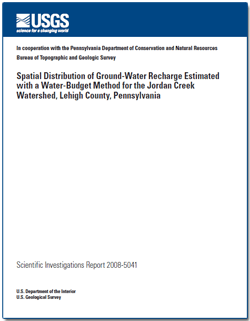Scientific Investigations Report 2008–5041
ABSTRACT
This report presents the results of a study by the U.S. Geological Survey, in cooperation with the Pennsylvania Geological Survey, to illustrate a water-budget method for mapping the spatial distribution of ground-water recharge for a 76-square-mile part of the Jordan Creek watershed, northwest of Allentown, in Lehigh County, Pennsylvania. Recharge was estimated by using the Hydrological Evaluation of Landfill Performance (HELP) water-budget model for 577 landscape units in Jordan Creek watershed, delineated on the basis of their soils, land use/land cover, and mean annual precipitation during 1951-2000. The water-budget model routes precipitation falling on each landscape unit to components of evapotranspiration, surface runoff, storage, and vertical percolation (recharge) for a five-layer soil column on a daily basis. The spatial distribution of mean annual recharge during 1951-2000 for each landscape unit was mapped by the use of a geographic information system. Recharge simulated by the water-budget model in Jordan Creek watershed during 1951-2000 averaged 12.3 inches per year and ranged by landscape unit from 0.11 to 17.05 inches per year. Mean annual recharge during 1951-2000 simulated by the water-budget model was most sensitive to changes to input values for precipitation and runoff-curve number. Mean annual recharge values for the crop, forest, pasture, and low-density urban land-use/land-cover classes were similar (11.2 to 12.2 inches per year) but were substantially less for high-density urban (6.8 inches per year), herbaceous wetlands (2.5 inches per year), and forested wetlands (1.3 inches per year). Recharge rates simulated for the crop, forest, pasture, and low-density urban land-cover classes were similar because those land-use/land-cover classes are represented in the model with parameter values that either did not significantly affect simulated recharge or tended to have offsetting effects on recharge. For example, for landscapes with forest land cover, values of runoff-curve number assigned to the model were smaller than for other land-use/land-cover classes (causing more recharge and less runoff), but the maximum depth of evapotranspiration was larger than for other land-use/ land-cover classes because of deeper root penetration in forests (causing more evapotranspiration and less recharge). The smaller simulated recharge for high-density urban and wetland land-use/land-cover classes was caused by the large values of runoff-curve number (greater than 90) assigned to those classes. The large runoff-curve number, however, certainly is not realistic for all wetlands; some wetlands act as areas of ground-water discharge and some as areas of recharge. Simulated mean annual recharge computed by the water-budget model for the 53-square-mile part of the watershed upstream from the streamflow-gaging station near Schnecksville was compared to estimates of recharge and base flow determined by analysis of streamflow records from 1967 to 2000. The mean annual recharge of 12.4 inches per year simulated by the water-budget method for 1967-2000 was less than estimates of mean annual recharge of 19.3 inches per year computed from the RORA computer program and base flow computed by the PART computer program (15.1 inches per year). In theory, the water-budget method provides a practical tool for estimating differences in recharge at local scales of interest, and the watershed- average recharge rate of 12.4 inches per year computed by the method is reasonable. However, the mean annual surface runoff of 4.5 inches per year simulated by the model is unrealistically small. The sum of surface runoff and recharge simulated by the water-budget model (16.9 inches per year) is 7 inches per year less than the streamflow measured at the gaging station near Schnecksville (23.9 inches per year) during 1967-2000, indicating that evapotranspiration is overestimated by the water-budget model by that amount. This discrepancy casts some doubt about the accuracy of the results from the water-budget model--including recharge rates. Although incorrect estimates of input parameters could be responsible for the apparent overestimate of evapotranspiration, limitations in the model algorithms also could be responsible. |
Posted May 2008 For additional information contact: Part or all of this report is presented in Portable Document Format (PDF); the latest version of Adobe Reader or similar software is required to view it. Download the latest version of Adobe Reader, free of charge. |
Risser, D.W., 2008, Spatial distribution of ground-water recharge estimated with a water-budget method for the Jordan Creek watershed, Lehigh County, Pennsylvania: U.S. Geological Survey Scientific Investigations Report 2008-5041, 26 p.
Abstract
Introduction
Purpose and Scope
Previous Investigations
Study Area
Water-Budget Method
Description of the Water-Budget Model
Automated Application of the Model
Delineation of Landscape Units
Soils
Land Use/Land Cover
Precipitation
Model Parameters for Jordan Creek Watershed
Climate Data
Precipitation
Temperature
Solar Radiation
Wind Speed
Relative Humidity
Vegetation Data
Growing Season
Leaf-Area Index
Evaporative-Zone Depth
Soils Data
Layer Thickness
Porosity
Wilting Point
Field Capacity
Runoff Data
Recharge Estimates
Spatial Distribution of Recharge
Factors Affecting Simulated Recharge
Comparison to Other Recharge Estimates
Comparison to Streamflow Measurements
Summary and Conclusions
References Cited
Appendix